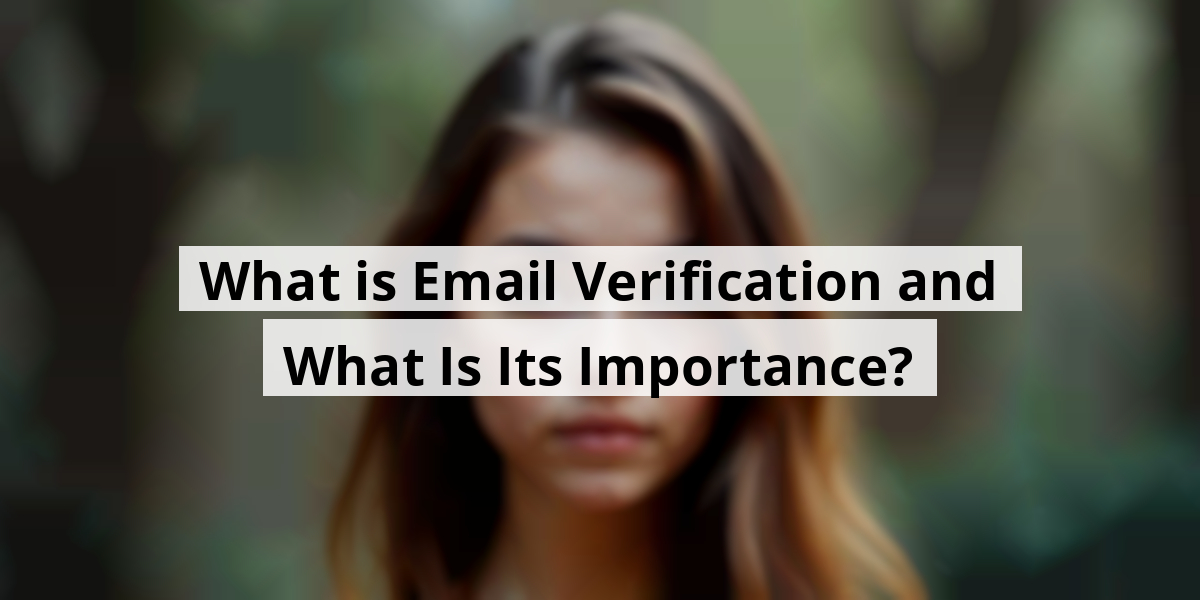 LIMITED SPOTS
All plans are 30% OFF for the first month! with the code WELCOME303
LIMITED SPOTS
All plans are 30% OFF for the first month! with the code WELCOME303

 LIMITED SPOTS
All plans are 30% OFF for the first month! with the code WELCOME303
LIMITED SPOTS
All plans are 30% OFF for the first month! with the code WELCOME303


Now we are going to talk about email verification and why it’s more important than remembering Aunt Karen’s birthday (trust us, that’s a trap you don’t want to fall into). It’s like giving our emails a little identity check before sending them off into the digital wild.
Email validation is simply checking if an email address is real, active, and ready to receive our witty messages.
When we think about it, we’re ensuring the email address has the right format, sits on an acceptable domain, and belongs to a mailbox that hasn't been abducted by aliens. Email validation plays a crucial role in many areas, from email marketing to onboarding new users and even keeping fraudsters at bay. After all, we don’t want to be the ones who send an invitation to our virtual party only for it to bounce back like a rubber ball.
Ensuring messages successfully reach the right inbox isn’t just about proper delivery; it's about maintaining a good reputation. Imagine being the email equivalent of a lady who shows up at a party, but no one knows who she is. Everyone’s like, “Who invited her?” or worse, they just pretend not to see her. By utilizing a professional domain email, we’re not just sending messages; we’re building trust. You wouldn’t walk around with a name tag that says “Betty from Accounting” if you’re actually “Betty the Brand Champion,” right? Besides, a verified email gives our messages a fighting chance against spam filters—trust us, they’re less picky with trustworthy folks.
So, what happens when we fire off a verified email? We make sure it lands where it should, increasing our chances of a solid communication line with the recipient. This builds customer relationships that might just last longer than our New Year’s resolutions!
In summary, by ensuring email addresses are properly validated, we’re not just being cautious; we’re superheroes in disguise. Our capes may just have the little icons of “verification” on them, but trust us, we’ve saved more than a few reputations with that! So the next time we’re about to hit ‘send’, let’s double-check those addresses and send our emails off like they’re on a first-class flight, not a Greyhound bus!
Now we are going to talk about how email validation ensures we don’t end up chatting with the digital equivalent of a ghost. Seriously, there’s nothing worse than sending an email only to realize you’ve been talking to a wall! So let’s break it down.


Email validation is like giving your email list a good shake, like trying to remove crumbs from a couch cushion. You start by making sure that every email address is, well, an actual email address. Here’s a quick rundown:
If you’re juggling contacts in Microsoft Dynamics 365, implementing email validation can save you the headache of dealing with failed messages. It keeps your CRM clean and makes sure your outreach doesn’t end up like a poorly thrown spaghetti at the wall. And if you're considering new CRM options, checking out Dynamics 365 pricing can help you figure out what best suits your needs.
Now we are going to talk about why verifying your email list is crucial for boosting marketing efforts and ensuring your messages land where they should—right in the inbox!

Email verification isn’t just a box to check; it’s like that trusty Swiss Army knife we never knew we needed in our marketing toolbox. Ever had that moment when an email bounces back? That’s like handing out flyers at a party, only to have them come flying back at you. Not cool, right? Well, here are some prime reasons why we should take email verification seriously:
To quantify some of these benefits, let’s check out the following table:
| Benefit | Details |
|---|---|
| Deliverability | Improved chance of inbox placement and lower spam flags. |
| Cost Efficiency | Lower email marketing costs through list cleaning. |
| Engagement | Higher open and click-through rates with valid contacts. |
So, folks, let’s keep those inboxes vibrant and engaging by verifying our emails! With one easy step, we can cut down costs, boost engagement, and make sure our messages don't end up lost at sea.
Now we are going to talk about how following regulations can keep our email practices on the straight and narrow.
Compliance is not just a buzzword tossed around in boardrooms; it's like that friend who reminds us to wear a jacket when it’s freezing outside. Neglecting email verification and its legal aspects can lead to hefty penalties and a damaged reputation. We’ve all heard the horror stories—businesses hit with fines that resemble small fortunes for violating data privacy rules. Ouch! Who has that kind of cash lying around? Take GDPR, for instance. This regulation, with its strict guidelines, dictates how businesses within the European Union juggle customer data.
While sipping on coffee in one café, it struck us how the differences in U.S. data handling laws can feel like a state-by-state scavenger hunt. Take California's laws, for instance. They’re like the overzealous parent at a school play, making sure every detail aligns perfectly. The CCPA aims for transparency in customer data use. Seriously, if you’re in California, think of it as a game of data peekaboo. You must show customers what you’re doing with their information!
But on the flip side, Florida gives off a chill vibe, as if it’s saying, “Don’t worry, buddy!” The LLC laws are more relaxed, focusing less on privacy. However, businesses in sunny Florida can’t just kick back. There’s still the CAN-SPAM Act lurking in the background, popping up when they least expect it, reminding them to play nice with email marketing.
So here’s the kicker: not being compliant can cost us the big bucks, or worse, our loyal customers. Here’s a quick rundown of essential reasons to embrace compliance in email verification:
In a world filled with laws and regulations, remembering to keep things above board provides peace of mind. No one wants their business spotlighted for all the wrong reasons. So let’s keep compliance on our radar—not just to avoid hefty fines, but because it’s good business. We could all use a little less stress and a lot more coffee breaks. Cheers to that!
Now we are going to discuss how to keep your email verification sharp and efficient. Spoiler alert: You might even find a chuckle or two along the way!


Everyone’s been there—accidentally typing your email, but instead of myname@gmail.com, you end up with myname@@gmail.com. With real-time email checks, those little typos can’t sneak past you. Imagine a user fills out a form, and as they type, the system quickly waves a red flag if things look fishy. This way, you will avoid the headaches of sorting through junk later. It’s like having a tech-savvy friend beside you at the coffee shop, reminding you to double-check those little mistakes!
The double opt-in is like the second round in a game show; you want to ensure they’ve got what it takes to play. So, after users submit their emails, send them a confirmation note—think of it as a polite “Hey, are you really interested in our chat?” If they don’t click the link in that email, guess what? They’re out. You only want the enthusiastic folks in your corner; those who genuinely want to hear from you.
Imagine having a fridge packed with expired leftovers. Not fun, right? An email list can turn stale faster than a loaf of bread. Complaints roll in, and engagement drops if we aren’t vigilant. Monthly clean-ups can save the day: toss out the bounces and ping users to refresh their details. Make it a habit! Keeping your list fresh keeps your communication crisp.
Think of bounce rates as your email’s health report. A high bounce is like an alarm bell ringing in your ear! There are hard bounces—when someone's email has flat-out disappeared into the ether—and soft bounces, which usually involve temporary hurdles. Monitoring can save your sender reputation from a nosedive. Know the difference and handle those bounces like they’re hot potatoes—don’t hold onto them!
Grouping like-minded subscribers can work wonders. Think of it as organizing a potluck. You wouldn’t bring a fruit salad to a barbecue, right? Tailor your messages to different groups based on how they engage. Track who opens your emails, and you’ll be golden in sending relevant content straight to them.
Buying email lists might feel like a shortcut, but it’s the equivalent of inviting strangers to your birthday party. Not cool! These lists can be riddled with bad addresses, and your emails could land in hot water—or worse, in the spam folder. Grow your list organically: polite pop-ups or lead magnets are more effective methods.
If you’re ignoring your email campaign stats, it’s like driving blindfolded. Open rates, click-through rates, and unsubscribes are your GPS. If your open rates are plummeting, it’s a telltale sign to shake things up. Establish a baseline, then compare. Use A/B testing to see what resonates more with verified addresses. Data doesn’t lie!
Nobody wants to comb through lists manually, right? Embrace automation! When selecting tools, look for features that make your life easier, such as real-time verifications and bulk cleaning. Integrations with your existing systems can supercharge this process, filtering out the sketchy emails before they even hit your inbox.
Now we are going to talk about why email verification is like that trusty doorman at a fancy club, making sure only the right guests get in. Think of all the times you've scrolled through messages filling your inbox like it’s Black Friday, only to find a bunch of bouncers—in this case, fake email addresses. They can really put a damper on your email marketing vibe!